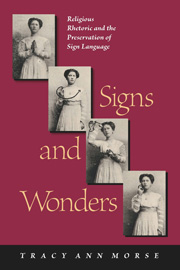Religious Rhetoric and the Preservation of Sign Language
Tracy Ann Morse
March 2014
|
View the table of contents. Read chapter two. Read reviews: The Midwest Book Review, Communication Design Quarterly Review. |
$45.00s print edition $45.00 e-book |
Current academic discourse frequently understates the role of religion in the development of the American Deaf community. In her new study, Tracy Ann Morse effects a sharp course correction by delineating the frequent use over time of religious rhetoric by members of the Deaf community to preserve and support sign language.
In Chapter One, Morse analyzes Thomas Hopkins Gallaudet’s use of religious references in his 1817 maiden address at the first American school for deaf students. She examines his and other speeches as examples of the intersection of education for deaf Americans and Protestant missionary efforts to convert them. In the second chapter, she presents the different religious perspectives of the two deaf education camps: Manualists argued that sign language was a gift from God, while Oralists viewed hand gestures as animal-like, indicative of lower evolutionary development.
Chapter Three explores the religious rhetoric in churches, sanctuaries where sign language flourished and deaf members formed relationships. In the fourth chapter, Morse shows how Deaf activist George Veditz signed using religious themes in his political films. She also comments on the impact of the bilingual staging of Big River: The Adventures of Huckleberry Finn, which began to change the hearing world’s opinion about the Deaf community. Morse concludes with speculation on the shifting terrain for deaf people due to technological innovations that might supplant religious rhetoric as a tool to support the Deaf community.
Tracy Ann Morse is an assistant professor and director of Composition/Writing Foundations in the Department of English at East Carolina University in Greenville, NC.
Print Edition: ISBN 978-1-56368-601-6, 6 x 9 paperback, 168 pages, 11 photographs
$45.00s
E-Book: ISBN 978-1-56368-602-3
$45.00
To order by mail, print our Order Form or call:TEL 1-800-621-2736; (773) 568-1550 8 am - 5 pm CST
TTY 1-888-630-9347
FAX 1-800-621-8476; (773) 660-2235
